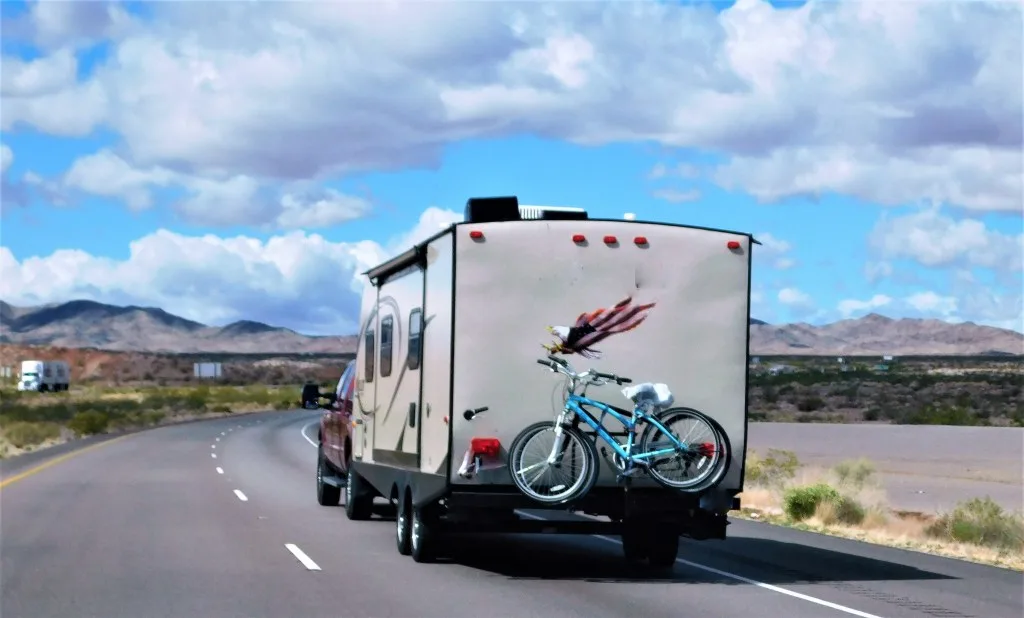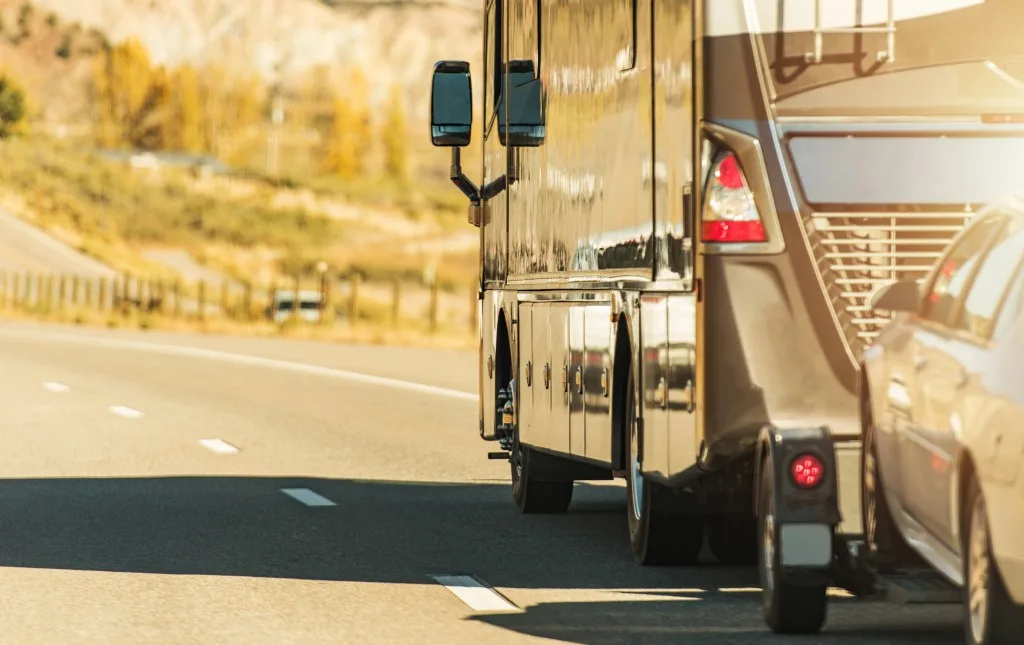Many drivers find that using the carpool lane on an interstate can help them avoid congestion and reduce travel time. However, these lanes have rules and sometimes tolls. If planning an RV trip soon, you may wonder if you can tow in the carpool lane.
These are valid questions to ensure you stay on the right side of the law.
Today, we’ll tackle these questions and provide you with all the information you might need for using the carpool lane. Let’s dive in.
What Is a Carpool Lane?
Carpool lanes are shared traffic lanes found primarily along interstates in densely populated areas. These traffic lanes restrict their use to vehicles with a certain number of passengers, typically two or more. Restrictions on these lanes often are only during peak travel times, primarily the morning and evening commute.
These special lanes often get called “HOV” lanes, which stands for “high-occupancy vehicle.”
Highway officials use a black and white diamond shape to mark these lanes. You’ll usually find them in the furthest lane to the left but can also veer off in an entirely separate section of the road.
Some states have begun to toll these roads differently, which means solo drivers can use these lanes, but only if they pay the toll. Some states even allow electric and other environment-friendly green vehicles to use these lanes unrestricted too.
Can You Tow in the Carpool Lane?
Like many other traffic laws, the individual state sets the rules for carpool lanes. This can make it rather confusing as some states allow RVers to use the carpool lane while others do not. Fifteen states allow all vehicles to use the carpool lane.
These states include Arizona, Kentucky, Nevada, North Carolina, Ohio, Oklahoma, Oregon, Pennsylvania, Tennessee, Texas, Utah, Vermont, Virginia, Washington, and Wisconsin. However, drivers must still meet the occupancy and speed requirements.
Pro Tip: Save at the gas pump by using these tips on How to Improve MPG When Towing.

Can You Tow a Trailer in the HOV Lane in California?
Unfortunately, California doesn’t allow vehicles towing a trailer to use the HOV lane. California is one of the country’s strictest states regarding towing trailers. The Golden State has a state-wide speed limit of 55 miles per hour for all vehicles towing.
It doesn’t matter if you’re on an interstate with a 70-mile-per-hour speed limit; all towing must follow the reduced speed or risk getting a ticket.
Can RVs Go in the Carpool Lane?
Regulations for the use of carpool lanes vary from state to state. However, the purpose of these lanes is to give those drivers traveling faster an opportunity to pass slower traffic. Many states have reduced speed limits for RVs and other towing vehicles, which means RVers would likely have to exceed the speed limit to use the carpool lane.
You’ll also need to consider the type of RV you have. States may classify any vehicle towing a trailer as an oversized vehicle, restricting them to only using the right lanes. Some smaller motorhomes may be exempt from these rules, but only if not towing an additional vehicle behind them.
The use of these lanes can be confusing. However, if you plan to use them, brush up on the laws for the states where you plan to travel. Law enforcement will issue citations for improper use of carpool lanes, which can come with a rather hefty fine.

What Are the Rules for the Carpool Lane?
The biggest rule for using the carpool lane is that vehicles must have more than one occupant. This rule can vary as some states exempt motorcycles or green cars. If you’re legally allowed to use the lane, there are some basic rules you need to follow.
You should never cross a solid line to enter or exit a carpool lane. If you have vehicles behind you, leave the carpool lane to allow the faster traffic to pass, but only at designated entrance points. Additionally, be mindful of any signage indicating specific hours or the number of required occupants to use the carpool. Many of these lanes default to standard traffic lanes except during rush hour.
Rules will vary from one state to the next. Make sure you familiarize yourself with local laws and any other states where you plan to use them. Improper carpool lane use can cost you hundreds of dollars and potentially increase your insurance premium.
Which Lane Should a Driver Be in While Towing a Trailer?
Towing a trailer can be very dangerous, and one of the best ways to increase safety is by reducing your speed. As a result, most drivers will need to stay in the right traffic lanes. In many more densely populated and urban areas, vehicles towing a trailer must stay out of the left lane or two. Drivers should watch for lane restrictions when hauling based on the location.
Lane restrictions for vehicles towing a trailer are also common in hilly or mountainous areas. RVs will typically have a harder time climbing steep grades, resulting in unnecessary traffic congestion if they block faster traffic from passing.
So keep an out for any signage indicating which lanes you can legally use while towing a trailer. When in doubt, keep right.

How Do You Find Road Rules for the State Where You’re Towing?
Road rules vary and constantly change. Look to the state’s Department of Motor Vehicle website for the best information. States typically do an excellent job putting the most up-to-date information on their websites to keep drivers informed of any changes.
As road rules constantly change, some information published on blogs and websites can be outdated. You better work on your sweet talking skills if trusting unofficial sources for information for rules of the road.
How Do You Safely Tow a Trailer?
One of the keys to towing a trailer starts before you even pull out onto the highway. A solid pre-trip inspection can help a driver catch potential safety issues. Inspecting tires and even checking tire pressure can be especially helpful. Ensuring all lights and signals function correctly can help a driver communicate with other drivers.
Additionally, plan your trip before you hit the road. Be mindful of any height, weight, or propane restrictions that could require you to change your route. An RV GPS can allow you to input your trailer’s weight and dimensions and help ensure you avoid any potentially dangerous situations.
Once on the highway, keep your speed in check. Speeding and RVing aren’t compatible, especially if you want to maximize safety. Following the towing speed limit can help a driver with extended braking distances and help avoid issues with exceeding the speed ratings on their tires.
Pro Tip: Before you hit the highway, make sure you know these 7 Common Towing Capacity Mistakes.
How Fast Can You Safely Tow a Trailer?
Most RVers never exceed 65 miles per hour, regardless of the speed limit. Trailer tires often have much lower speed ratings than standard vehicles. Subjecting tires to excessive speeds can increase the amount of friction between the tire and the road, which can generate too much heat. This causes tires to wear down faster and can even cause a major tire failure.
A blown tire can easily do thousands of dollars in damage to an RV and potentially cause a dangerous accident.
So avoid towing in the carpool lane to not hinder traffic, and always follow the speed limits. Practice safe driving and hauling at all times, and enjoy your trip.
Have you towed in a carpool lane? Tell us about your experience in the comments!
Discover the Best Free Camping Across the USA
To be honest with you, we hate paying for camping. There are so many free campsites in America (with complete privacy).
You should give it a try!
As a matter of fact, these free campsites are yours. Every time you pay federal taxes, you’re contributing to these lands.
Become a FREE CAMPING INSIDER and join the 100,000 campers that love to score the best site!
We’ll send you the 50 Best Free Campsites in the USA (one per state). Access the list by submitting your email below: